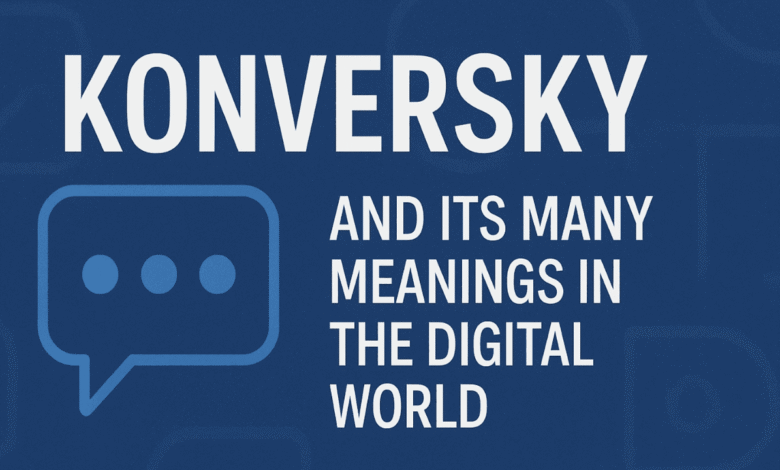Konversky and Its Many Meanings in the Digital World

The word konversky has been appearing in different conversations across design, communication, and digital identity. For many people, it may seem like an unusual or even unfamiliar term, yet its presence in discussions about technology, branding, and creativity makes it worth exploring. In this article, we will look at the different sides of konversky, how it has been interpreted, and why it continues to be a subject of interest for designers, creators, and innovators.
1. Understanding what konversky represents
Konversky is not a single fixed concept. Instead, it has been used in multiple ways, each carrying its own meaning. For some, it represents a design framework that treats communication as a conversation rather than a one-way process. For others, it is presented as a next-generation communication platform that blends messaging, translation, and collaboration. In another context, konversky is simply a symbolic or brandable name that creators use to express identity, curiosity, and originality.
This flexibility makes konversky more of a layered idea than a single definition. The name itself carries a sense of mystery, which helps it gain attention and spark interest in different industries.
2. Konversky as a design and interaction framework
One of the most fascinating uses of konversky is in design thinking and user interaction. Instead of looking at design as a static element, the konversky idea treats it as an ongoing conversation between the user and the system. Interfaces built under this idea are not only functional but also emotionally responsive, adapting to the needs of the user in real time.
For example, when someone interacts with a digital product, the goal is not just to complete a task but to feel understood and guided. The konversky framework highlights the importance of empathy, personalization, and adaptability in digital spaces. This approach helps designers rethink the way they build experiences, focusing less on rigid structures and more on natural flow.
3. Konversky as a futuristic communication platform
Another dimension of konversky is its description as a potential all-in-one communication tool. In this form, konversky is imagined as a platform that brings together multiple functions in a single environment. These include messaging, real-time translation, video and voice calling, task management, and even emotional understanding.
The idea is that konversky could make conversations smoother by not only connecting people but also reducing barriers such as language or workflow complexity. Features like end-to-end privacy, intuitive design, and sentiment awareness are often linked with this version of konversky. While this may sound ambitious, the thought behind it reflects the increasing demand for tools that support human-centric communication and collaboration.
4. Konversky in cultural identity and branding
Outside of design and communication technology, konversky is also seen as a strong name for branding. It has a unique and memorable sound, making it stand out in a world filled with generic labels. Because it does not have a fixed historical meaning, creators can shape konversky into whatever they need it to represent—whether it is a business, a digital project, or a creative identity.
This brandable nature gives konversky an edge in digital marketing and search visibility. People are naturally curious about unusual words, and that curiosity often translates into higher engagement and recognition. For entrepreneurs and creators, this flexibility makes konversky an appealing choice when trying to build something distinct.
5. The symbolic meaning of konversky in digital culture
On a broader cultural level, konversky can be seen as a symbol of how modern terms gain meaning through context rather than origin. Instead of being tied to a single definition, it reflects the way digital culture assigns value to names through usage. The fact that konversky has been used in design, communication, branding, and even speculative discussions shows how words today can evolve quickly and adapt to different narratives.
In many ways, konversky demonstrates how people are drawn to concepts that are open enough to be interpreted in multiple ways yet specific enough to spark imagination.
6. Key points to consider about konversky
To understand the depth of this concept, here are some key points worth noting:
- Konversky is flexible and has been used in several industries.
- It can represent a design framework based on interaction and empathy.
- It is also presented as a vision for an advanced communication platform.
- Its unique name makes it valuable in branding and digital identity.
- It symbolizes how modern culture shapes meaning around creativity and innovation.
These points help capture the wide spectrum of ideas linked to konversky without limiting it to a single field.
7. Why konversky continues to attract attention
The reason konversky continues to be discussed is its open nature. Unlike many terms that have a strict definition, this one leaves room for interpretation. For designers, it is a way to rethink how humans and systems interact. For businesses, it is a unique and powerful name to build a brand. For communication experts, it represents the dream of a unified platform that handles complexity with simplicity.
In all these cases, konversky acts as a bridge between imagination and practicality. It has enough grounding to make sense in real applications, yet enough openness to invite creative thought.
Conclusion
Konversky may not have a single clear origin or meaning, but that is exactly what makes it so intriguing. It can be understood as a design philosophy, a futuristic communication tool, or a powerful cultural brand. Its adaptability shows how language and concepts evolve in the digital world, often shaped more by use than by history.
As people continue to explore new ways of connecting, designing, and building identity, konversky will likely remain a term that sparks curiosity and conversation. It stands as an example of how modern culture creates value not only through technology but also through the ideas and names that define it.



